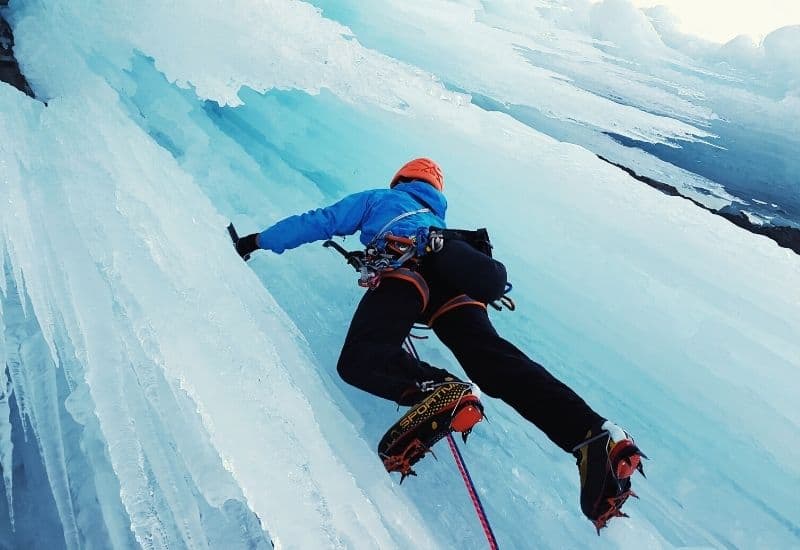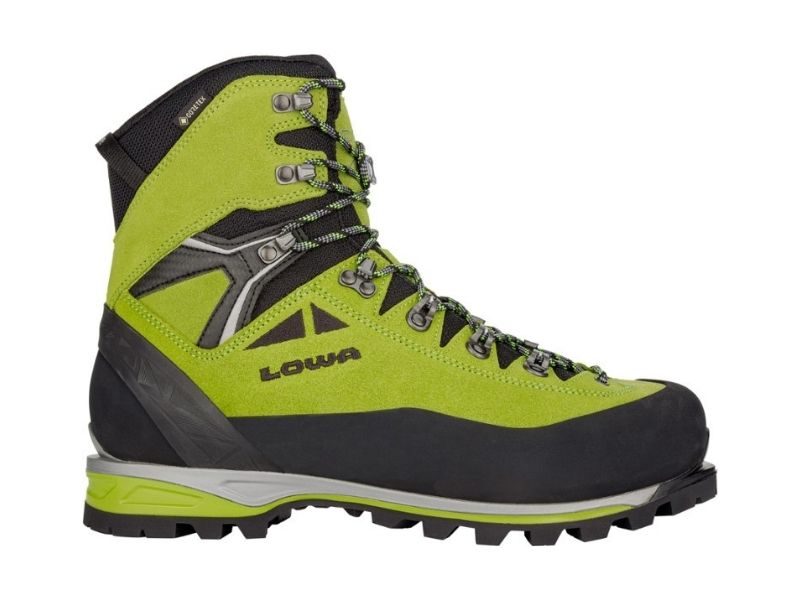When scaling steep ice and snow, it’s crucial to use the most suitable gear; anything less may result in grim eventualities like frostbite, frostnip, or even the ‘screaming barfies’. To help you with your ice climbing footwear choice we’ve compiled our list of the top winter climbing boots for men and women.
Our overall favorite were the Scarpa Phantom Tech, with the La Sportiva G2 Evo, Scarpa Mont Blanc Pro GTX, La Sportiva Nepal Cube GTX, Arc’teryx Acrux AR, Lowa Alpine Expert GTX, La Sportiva Trango Tower Extreme GTX, and La Sportiva Makalu all well worth considering.
We discuss the important features to look for in ice-climbing boots such as the difference between single vs. double boots, liners, material, weight, stiffness, built-in gaiters, and crampon compatibility. And to further help you choose we cover what type of boot is best suited to use for ice climbing, mixed climbing, or mountaineering.
Do
Don’t
Table of Contents
At a Glance: Quick Recommendations
-
Editor’s Choice:
Scarpa Phantom Tech
“A highly technical, lightweight boot that excels on both high-grade ice and technical mountaineering routes.” -
Runner Up:
La Sportiva G2 Evo Mountaineering Boot
“A no-nonsense synthetic boot that’s ideal for ice climbing in colder climates or ascents of high mountain peaks.” -
Best All-Rounder:
Scarpa Mont Blanc Pro GTX
“A robust, versatile, performance-oriented single boot that excels on everything from steep snow slopes to mixed gullies and mid-grade ice.” -
Best for Mountaineering:
La Sportiva Nepal Cube GTX Mountaineering Boots
“A longstanding favorite of mountaineers and ice climbers everywhere.” -
Best Lightweight Double Boot:
Arc’teryx Acrux AR
“A sleek, lightweight, highly agile boot designed for technical ascents in frigid climes.” -
Honorable Mention:
Lowa Alpine Expert GTX Mountaineering Boot
“A versatile boot that ticks all the boxes for frequent baggers of snowy peaks who like to dabble in a bit of ice climbing.” -
Best Value:
La Sportiva Trango Tower Extreme GTX Mountaineering Boot
“Lightweight, versatile boots that excel on rock climbs, steep winter hikes, and moderate icefalls.” -
Best Budget:
La Sportiva Makalu Mountaineering Boot
“These non-technical, all-around mountaineering boots lack insulation and rigidity but are nevertheless a good pick for winter hikers who’d like to try their hand on a few low-grade ice climbs.”
What Are The Best Mountaineering Boots For Ice?
Our top picks for ice climbing mountaineering boots are listed below, with the Scarpa Phantom Tech scooping our editor’s choice award.
- Scarpa Phantom Tech
- La Sportiva G2 Evo Mountaineering Boot
- Scarpa Mont Blanc Pro GTX
- La Sportiva Nepal Cube GTX
- Arc’teryx Acrux AR Mountain Boots
- Lowa Alpine Expert GTX
- La Sportiva Trango Tower Extreme GTX Mountaineering Boot
- La Sportiva Makalu
Scarpa Phantom Tech
Editor’s ChoiceThe Scarpa Phantom Tech earns our award as this year’s top boot for ice climbing, excelling on high-grade ice, mixed climbs, and high peaks.
The Phantom Tech, also available in a womens version, is a single boot but one of the warmest of that kind on the market thanks to its beefy (but not bulky) Primaloft insulation and integrated gaiter. In terms of agility and precision, this boot leaves both of the double boots on our list, and most of the singles, trailing in its wake.
The sole of the Phantom Tech is stiff enough for long pitches of vertical ice but has enough flex to prevent discomfort on approaches. On the inside, there’s an HDry waterproof membrane to fend off meltwater, and on the outside an integrated gaiter with a water-tight zipper that provides a reliable first line of defense.
At 3 lbs. 3 oz., the Phantom Tech is one of the lightest boots in its performance class, besting competitors like the La Sportiva Nepal Cube and Scarpa Mont Blanc Pro by a whole 12 ounces.
Specs
- Type: Technical 4-Season Alpine Boot
- Material: Synthetic
- Weight: 3 lbs. 3oz.
- Crampon compatibility: Automatic and semi-automatic
PROs
- Lightweight
- Built-in gaiter keeps feet dry
- Highly waterproof
- Warm
- Agile for such a warm boot
- Synthetic upper dries fast
CONs
- Not as warm as the La Sportiva G2
Bottom-Line: For a technical snow, ice, and rock climbing boot that boasts an outstanding warmth-to-weight ratio, look no further than the Scarpa Phantom Tech.
La Sportiva G2 Evo Mountaineering Boot
Runner UpThe La Sportiva G2 Evo secures our runner-up spot, and is an excellent choice for ice climbing in particularly frigid environments or for tackling big peaks.
There’s no getting around the fact that this is a scarily expensive boot. However, the greatest indicator of its superiority is that it is still good value for money nonetheless.
At 4 lbs 10 oz, the G2 is among the heaviest boots on our list, but it’s also the warmest. As such, it’s our top pick for anyone aiming to summit peaks over 5,000 meters, take on frozen waterfalls in especially cold conditions, or winter climbers who are particularly prone to cold feet.
A few nice touches make the G2 stand out as compared to its peers geared towards the same end-use. The most notable of these are a tall, built-in gaiter that keeps the insulated inner boots dry and warm, and a dual Boa lacing system that is quick and easy to adjust even with thick gloves on.
While less agile and far heavier than the Phantom Tech, the G2 are our go-to for climbs in temps below the 15°F mark and/or at altitude.
Specs
- Type: 4-Season Technical Alpine Double Boot
- Material: Double synthetic
- Weight: 4 lbs. 10 oz.
- Crampon compatibility: Automatic and semi-automatic
PROs
- Excellent warmth-to-weight ratio
- Built-in gaiter
- Dual Boa lacing system
- Highly durable
- Removable inner boot
CONs
- Pricey
- Heavier than single boot competitors
Bottom-Line: A beast of a boot that excels at both high altitudes and on technical ice routes.
Scarpa Mont Blanc Pro GTX
Best All-RounderThe Scarpa Mont Blanc Pro (click here and here for the women’s version) is a great all-rounder and worthy addition to your shortlist.
The MB Pro GTX’s main selling points are its durability and versatility. Its leather construction makes it tough enough to deal with years of use and abuse, while its light-weight, precision-oriented outsole, and moderate insulation make it ideal for low-altitude mountaineering and steep icy climbs alike.
Not much separates this boot from the La Sportiva Nepal Cube (below), though the Mont Blanc Pro is a little cheaper, slightly more agile, and a better fit for people with wider feet.
Specs
- Type: 4-Season Technical Alpine Single Boot
- Material: Leather
- Weight: 3lbs. 15 oz.
- Crampon compatibility: Automatic and semi-automatic
PROs
- Extremely durable
- Agile
- Relatively lightweight
- Good ankle support
- Better fit for wider feet than La Sportiva Nepal Cube
CONs
- Not warm enough for high-altitude mountaineering
Bottom-Line: A tough, agile, and technical jack of all trades.
La Sportiva Nepal Cube GTX
Best for MountaineeringThe La Sportiva Nepal Cube GTX (click here and here for women’s version) has quickly established itself as one of the best boots for mountaineering.
Compared to its predecessor, the Cube GTX adds a built-in ankle gaiter, a removable tongue, and weighs a whole 8 oz. less, all of which make a great boot an even greater one.
While the Cube is a single boot, it’s warm enough for (most) winter mountaineering conditions in the lower 48. It’s also a light and agile boot for technical ice or mixed climbing and even three-season summit missions on the higher peaks, whether Mont Blanc, Rainier, or 6000ers like Island Peak.
The closest competition in the Cube’s niche of the market is the Scarpa Mont Blanc Pro GTX. The Mont Blanc Pro is cheaper and slightly more agile, but we found the Cube to be the warmer of the two by a fraction.
The only downside to the Cube is that it’s leather upper takes a little longer to dry out than synthetic materials.
Specs
- Type: 4-Season Technical Alpine Single Boot
- Material: Idro-Perwanger Roughout Leather Upper
- Weight: 3 lbs. 15 oz.
- Crampon compatibility: Automatic
PROs
- Versatile
- Comfortable
- Warm for a single boot
- Relatively lightweight
- Better fit for narrow feet than Scarpa Mont Blanc Pro
CONs
- Take longer to dry out
- Heavier than La Sportiva Trango
Bottom-Line: One of the best mountaineering boots out there for buyers looking for a “quiver of one” jack of all trades that excels in every environment.
Arc’teryx Acrux AR Mountain Boots
Best Lightweight Double BootThe Arc’teryx Acrux AR, our favorite lightweight double boot, is designed for ice climbers and mountaineers requiring ample warmth without compromising agility.
While the Acrux aren’t as warm as our list’s other double boot, La Sportiva G2 Evo, they’re a whole 8 oz. lighter and boast a sleek, streamlined design that allows them to excel in more technical terrain, whether that’s technical rock or steep ice and snow.
Both the inner and outer boot of the Acrux are made with synthetic material, so they dry faster when wet than a leather boot like the La Sportiva Nepal. The outer boot is also pleasingly streamlined and low-profile, something that’s sure to appeal to anyone who places a priority on agility and precision.
Specs
- Type: 4-Season Technical Alpine Double Boot
- Material: Double synthetic
- Weight: 4 lbs. 2 oz.
PROs
- Agile
- Lightweight for a double boot
- Built-in gaiter with fully waterproof zipper
- Tough as nails
- A super-stiff boot (maybe a ‘con’ for some)
CONs
- Not as warm as other double boots
- Pricey
Bottom-Line: A badass, double synthetic boot that offers an agility and precision upgrade on most of the competition.
Lowa Alpine Expert GTX
Honorable MentionThe Lowa Alpine Expert GTX (click here for womens version) gets an honorable mention for its versatility. A great choice for buyers seeking an affordable boot that performs well on ice and mixed routes yet is comfortable enough to put in multiple miles on the trails too.
While the Expert GTX isn’t warm enough for climbs in anything south of 25 degrees, they offer a comfort and agility upgrade on most competitors on this list thanks to their light weight, nimble feel, and precision-oriented design.
While they’re better suited to summer or shoulder-season missions on 14ers or peaks in the 4,000-5,000 meter range, their awesome heel lock allows them to front-point and tackle icy ascents very well. Unlike many alpine boots, the Expert GTX are also comfortable enough to wear on long approaches on rock, ice, scree, or trails.
Specs
- Type: 4-Season Technical Alpine Single Boot
- Material: Leather
- Weight: 3 lbs. 13 oz.
PROs
- Versatile
- Lightweight
- Durable
- 400g Primaloft insulation
CONs
- Heavy compared to other single boots
- Too flexible for steep, stiff, and sustained ice
Bottom-Line: A lightweight, technical single boot that’s comfortable enough to hike in but warm and stiff enough for moderate, less technical climbing on ice.
La Sportiva Trango Tower Extreme GTX Mountaineering Boot
Best ValueThe La Sportiva Trango Tower Extreme offers great value and is among our favorites for mixed climbing and mountaineering, especially when anticipating crampon-free technical rock climbs.
While they’re a little too flexible and won’t keep your feet warm enough for cold days in temps below 25 degrees, they’re solid performers on moderate ice and plenty warm for spring ascents of frozen waterfalls in most areas.
The Trango Tower Extreme is built with a combo of synthetic materials and leather and uses a Gore-Tex membrane to protect you from getting wet feet. They also have a low-cut, elastic cuff that keeps out snow.
Weighing just 3 lbs. 4 oz., these are also among the lightest boots on our list, so won’t tire out your legs on long approaches or summit missions.
Specs
- Type: Technical Alpine Single Boot
- Material: Synthetic
- Weight: 3 lbs. 4 oz.
- Crampon compatibility: Automatic and semi-automatic
PROs
- Lightweight
- Affordable
- Agile
- Versatile
- Great for technical climbing on alpine rock climbs and mixed routes
CONs
- Lack warmth
- Not the most durable
Bottom-Line: A lightweight, versatile, and affordable boot that offers solid all-around performance.
La Sportiva Makalu
Best BudgetThe La Sportiva Makalu is a great versatile boot well worth considering when you’re on a budget.
While the Makalu is far from being an out-and-out ice-climbing boot, its toe welt and heel welt mean it has automatic crampon compatibility (C3). And although this leather boot is short on insulation as compared to the other options on our list, it will provide just enough warmth for lower-level mountaineering and ice climbing in less frigid alpine environments.
We chose to include this boot on our list because of its versatility, and because not every hiker or occasional mountaineer wants to splash mega $ on a pair of boots they’re only going to use for a few months per year.
Therein lies the Makalu’s beauty. Outside those few months of the year, the Makalu will serve you well as hiking boots, backpacking boots, and summer mountaineering boots, something that can’t be said of most other models on our list.
Specs
- Type: General Mountaineering Boot
- Material: Idro-Perwanger leather
- Weight: 4 lbs. 5 oz
- Crampon compatibility: Automatic and Semi-Automatic
PROs
- Versatile
- Affordable
- Durable
CONs
- Not designed for extreme cold
- Less rigid sole not suitable for technical ice climbing
- Heavy compared to single-layer synthetic boots
Bottom-Line: A traditional mountaineering boot that’s just stiff and warm enough for low-grade ice climbing.
How to Choose Mountain Climbing Boots For Icy Conditions?
Key features to consider for choosing a pair of mountaineering hiking boots for icy conditions are listed below.
- Single Vs. Double Boots
- Liner
- Material
- Weight
- Stiffness
- Built-in Gaiter
- Crampon Compatibility
Single Vs. Double Boot
Ice-climbing boots come as a single or double boot option. Double boots comprise an outer shell with an internal removable liner, whereas single boots have no removable liner. Ultimately, your choice will come down to the temperatures you plan on climbing in and the agility required.
When mountaineering or ice-climbing, cold feet can determine whether your day is an enjoyable or miserable one, or worse, result in a smaller shoe size due to frostbite. Double boots like the La Sportiva G2 Evo and Arc’teryx Acrux are by far the warmer of the two options. These are a better choice for you (and your toes) if you anticipate climbing in temps below 15 °F or at higher altitudes, where your feet will feel cold quicker due to the lack of oxygen.
Single models, on the other hand, are generally a lighter and more flexible boot. They have less insulation and tend to have less rigid soles that allow you to walk further without discomfort. You’ll also be able to use them for summer summit bids and general mountaineering. Models like the Nepal Cube and Mont Blanc Pro pack plenty of insulation for winter mountaineering or most ice routes in the lower 48 and cost far less than doubles.
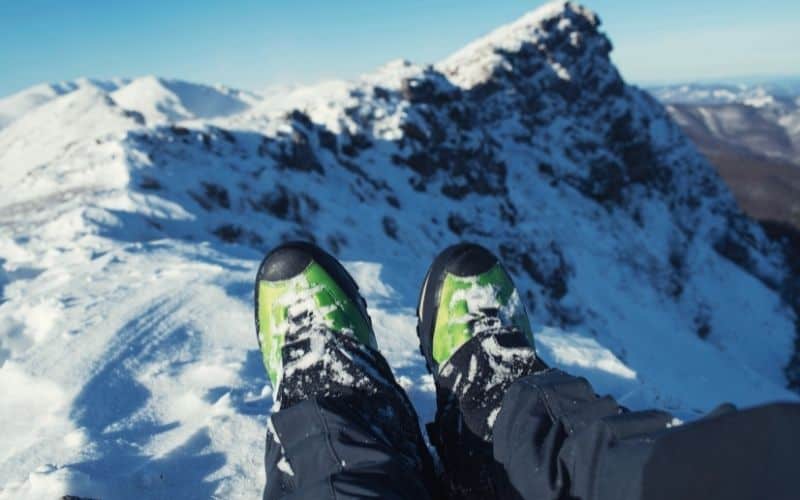
Liners
On double boots, the liner or inner boot provides the majority of the warmth. Liners are typically made of water-resistant materials like closed-cell foam and can be removed to dry at the end of the day at home or in your tent.
With single boots, the liner is built-in and far less substantial, meaning they provide less warmth and take longer to dry out when wet.
Material
The type of material used impacts the durability and flexibility of your boots. All options on our list are made with either leather or synthetic materials, but there are also models made from plastic.
Leather boots like the Nepal Cube and Mont Blanc Pro trump synthetics like the Phantom Tech in durability, but lose out on agility, mainly because of leather’s bulkiness and tendency to absorb water, which can add a hefty whack of weight to your feet.
Boots with a plastic shell are something of a rarity these days. While ultra-durable, cheap, and warm when combined with a burly inner boot liner, their bulk makes them the most cumbersome of the bunch. This makes them less suitable for icy ascents but an option for climbing high peaks like Denali or Himalayan 6000ers.
Weight
In most cases, there is a direct correlation between warmth and weight – the heavier the boot, the warmer it is. The trade-off in this metric is agility. Heavier boots make nimble footwork trickier and can lead to leg fatigue, particularly on longer routes.
Stiffness
Different levels of sole stiffness are required for different climbing types. For steep, icy ascents and technical mountaineering, a full-shank sole with little or no flex is optimal. For general mountaineering, more flexible boots like the Lowa Alpine Expert or Sportiva Trango Tower offer more comfort on flatter approaches and sufficient stability on low to moderate slopes up to 55 degrees.
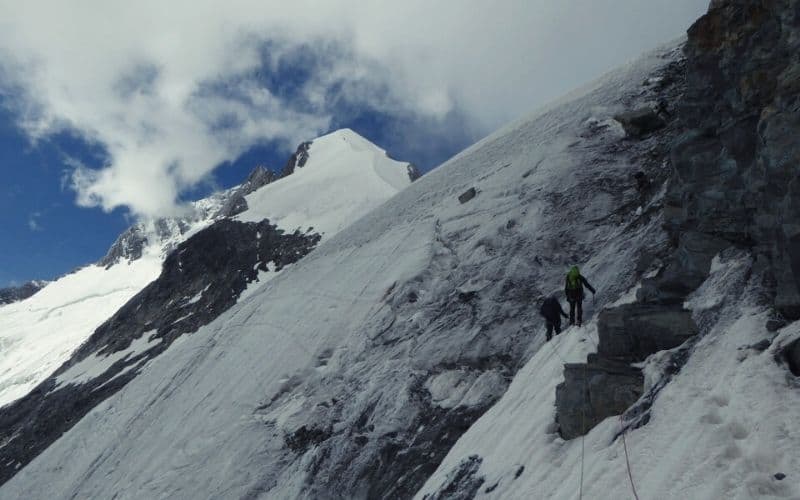
Built-in Gaiter
A built-in gaiter creates a water-tight seal, usually extending three-quarters or halfway up your shin. This adds warmth, prevents snow or water from sneaking in, and eliminates the need for a separate pair of gaiters. The downside is that built-in gaiters may be excessive in less extreme environments and likely to cause sweaty feet.
Crampon Compatibility
All boots on our list feature both toe welts and heel welts, making them compatible with both C3 (automatic) and C2 (semi-automatic) crampons. For more on crampon compatibility, check out this guide from Ellis Brigham.
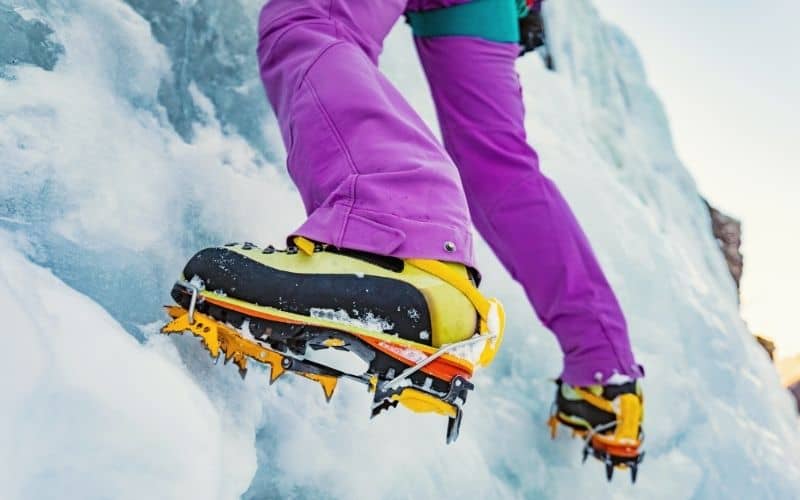
What Boot To Use For Ice Climbing, Mixed Climbing, or Mountaineering?
What boot you should choose for ice climbing, mixed climbing, or mountaineering depends on the technical difficulty of the climbs and the temperatures you expect to face.
For general mountaineering in most of the lower 48, a non-technical pair of leather boots like the Makalu or Lowa Alpine will do the trick, and also take a C3 crampon (or strap-on crampon, of course) for any steep terrain in ice or snow.
For “big hills” like Rainier, Hood, or Mont Blanc, or mixed climbs, a more technical single boot like the Scarpa Mont Blanc Pro GTX, Nepal Cube, or La Sportiva Trango Tower Extreme GTX will suffice, though you may want to upgrade to a double boot for winter ascents or if you do any out-and-out ice climbing on the side.
For technical mountaineering or ice climbing on routes at or above WI3, we recommend a stiff boot like La Sportiva Nepal Cube or Scarpa Mont Blanc Pro, though a burlier and even less flexible boot like the Scarpa Tech will serve you better the higher you go in the grades.
For high-altitude or winter climbs on big peaks, we recommend a technical double boot like the Scarpa Phantom Tech or La Sportiva G2 SM.
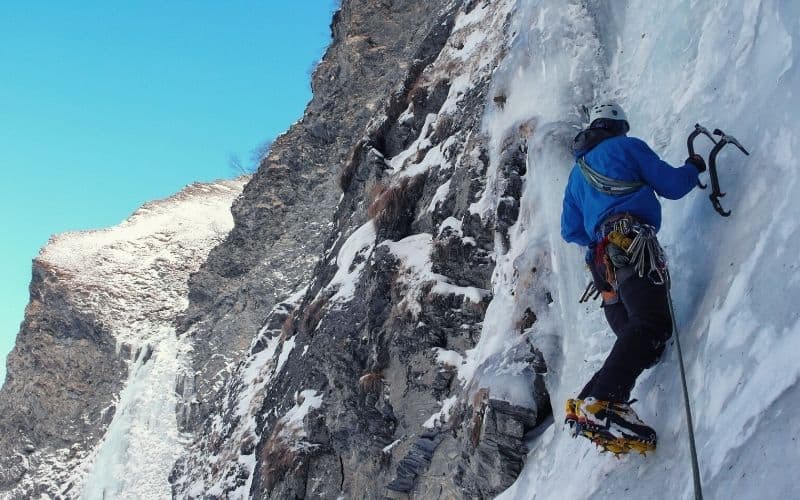
Best Ice Climbing Boots: The Verdict
For technical ascents on steep ice or mixed routes, our favorite is the agile and precision-oriented Scarpa Phantom Tech. These lightweight mountaineering boots tick every box and provide sufficient warmth for ascents from Ouray to Cogne.
Heading to higher altitudes? If so, we recommend a burlier boot like the La Sportiva G2 Evo. This double boot is toasty enough for 7,000-meter peaks and light enough for long days on vertical, high-grade ice.
Looking for more flexible boots for general mountaineering, mixed routes, and the odd foray onto icy terrain? If so, it’s a toss-up between the La Sportiva Nepal Cube and the Scarpa Mont Blanc Pro. As mentioned above, these are both great boots, and choosing between the two will ultimately come down to the shape of your feet.
How did you like our article? If you have any questions, please drop us a line in the comments box below. And if you’d like to share this post with your friends, feel free!
